Fable Legends Early Preview: DirectX 12 Benchmark Analysis
by Ryan Smith, Ian Cutress & Daniel Williams on September 24, 2015 9:00 AM ESTGraphics Performance Comparison
With the background and context of the benchmark covered, we now dig into the data and see what we have to look forward to with DirectX 12 game performance. This benchmark has preconfigured batch files that will launch the utility at either 3840x2160 (4K) with settings at ultra, 1920x1080 (1080p) also on ultra, or 1280x720 (720p) with low settings more suited for integrated graphics environments.
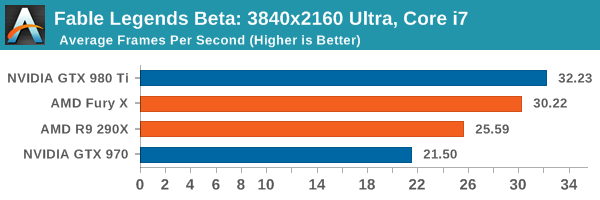

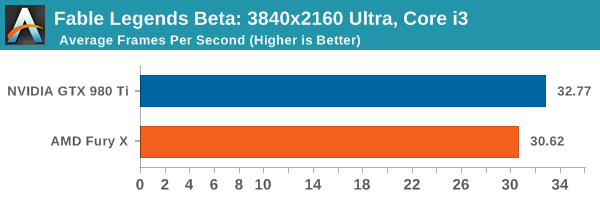
When dealing with 3840x2160 resolution, the GTX 980 Ti has a single digit percentage lead over the AMD Fury X, but both are above the bare minimum of 30 FPS no matter what the CPU.

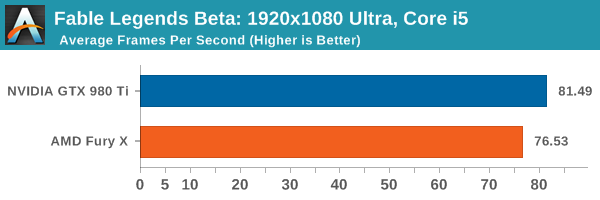
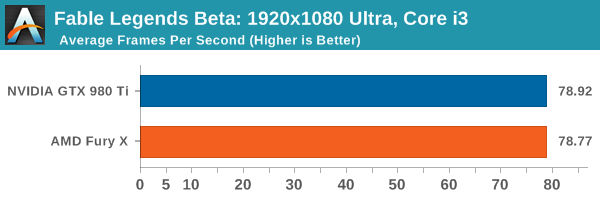
When dealing with the i5 and i7 at 1920x1080 ultra settings, the GTX 980 Ti still has that single digit percentage lead, but at Core i3 levels of CPU power the difference is next to zero, suggesting we are CPU limited even though the frame difference from i3 to i5 is minimal. If we look at the range of cards under the Core i7 at this point, the interesting thing here is that the GTX 970 just about hits that 60 FPS mark, while some of the older generation cards (7970/GTX 680) would require compromises in the settings to push it over the 60 FPS barrier at this resolution. The GTX 750 Ti doesn’t come anywhere close, suggesting that this game (under these settings) is targeting upper mainstream to lower high end cards. It would be interesting to see if there is an overriding game setting that ends up crippling this level of GPU.
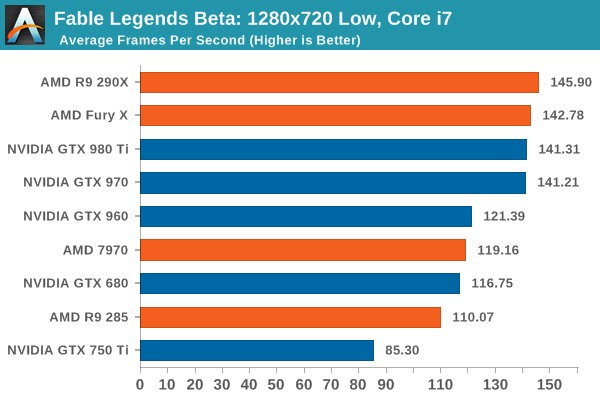
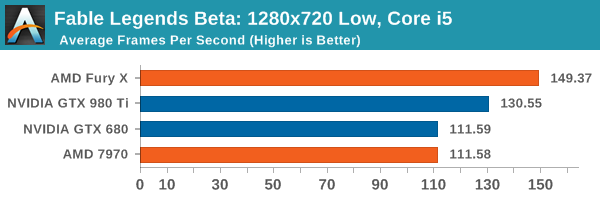
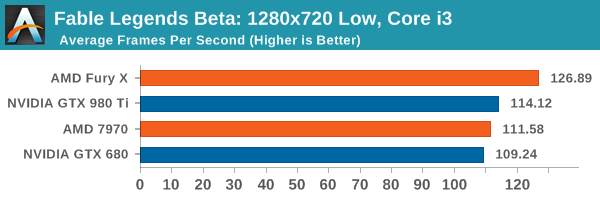
At the 720p low settings, the Core i7 pushes everything above 60 FPS, but you need at least an AMD 7970/GTX 960 to start going for 120 FPS if only for high refresh rate panels. We are likely being held back by CPU performance as illustrated by the GTX 970 and GTX 980 Ti being practically tied and the R9 290X stepping ahead of the pack. This makes it interesting when we consider integrated graphics, which we might test for a later article. It is worth noting that at the low resolution, the R9 290X and Fury X pull out a minor lead over the NVIDIA cards. The Fury X expands this lead with the i5 and i3 configurations, just rolling over to the double digit percentage gains.










141 Comments
View All Comments
HotBBQ - Friday, September 25, 2015 - link
Please avoid using green and red together for plots. It's nigh impossible to distinguish if you are red-green colorblind (the most common).Crunchy005 - Friday, September 25, 2015 - link
So we have a 680, 970, 980ti. Why is there a 980 missing and no 700 series cards from nvidia? The 700s were the original cards to go against things like the 7970, 290, 290x. Would be nice see whether those cards are still relevant, although the lack of them showing in benchmarks says otherwise. Also the 980 missing is a bit concerning.Daniel Williams - Friday, September 25, 2015 - link
It's mostly time constraints that limit our GPU selection. So many GPU's with not so many hours in the day. In this case Ryan got told about this benchmark just two days before leaving for the Samsung SSD global summit and just had time to bench the cards and hand the numbers to the rest of us for the writeup.It surely would be great if we had time to test everything. :-)
Oxford Guy - Friday, September 25, 2015 - link
Didn't Ashes come out first?Daniel Williams - Friday, September 25, 2015 - link
Yes but our schedule didn't work out. We will likely look at it at a later time, closer to launch.Oxford Guy - Saturday, September 26, 2015 - link
So the benchmark that favors AMD is brushed to the side but this one fits right into the schedule.This is the sort of stuff that makes people wonder about this site's neutrality.
Brett Howse - Saturday, September 26, 2015 - link
I think you are fishing a bit here. We didn't even have a chance to test Ashes because of when it came out (right at Intel's Developer Forum) so how would we even know it favored AMD? Regardless, now that Daniel is hired on hopefully this will alleviate the backlog on things like this. Unfortunately we are a very small team so we can't test everything we would like to, but that doesn't mean we don't want to test it.Oxford Guy - Sunday, September 27, 2015 - link
Ashes came out before this benchmark, right? So, how does it make sense that this one was tested first? I guess you'd know by reading the ArsTechnica article that showed up to a 70% increase in performance for the 290X over DX11 as well as much better minimum frame rates.Ananke - Friday, September 25, 2015 - link
Hmm, this review is kinda pathetic...NVidia has NO async scheduler in the GPU, the scheduler is in the driver, aka it needs CPU cycles. Then, async processors are one per compute cluster instead one per compute unit, i.e. lesser number.So, once you run a Dx12 game with all AI inside, in a heavy scene it will be CPU constrained and the GPU driver will not have enough resource to schedule, and it will drop performance significantly. Unless, you somehow manage to prioritize the GPU driver, aka have dedicated CPU thread/core for it in the game engine...which is exactly what Dx12 was supposed to avoid - higher level of virtualization. That abstract layer of Dx11 is not there anymore.
So, yeah, NVidia is great in geometry calculations, it's always been, this review confirms it again.
The_Countess - Friday, September 25, 2015 - link
often the fury X GAINS FPS as the CPU speed goes down from i7 to i5 and i3.3 FPS gained in the ultra benchmark going from the i7 to the i3, and 7 in the low benchmark between the i7 and the i5.